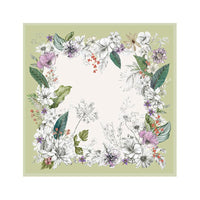The Paisley Pattern is a cultural totem that transcends time and space. Its shape resembles teardrops, cashews, and spiral branches and leaves. It was born in ancient Babylon, flourished in Persia and India, and eventually became popular all over the world under the name of "Paisley". This pattern is not only a treasure of decorative art, but also a carrier of religious beliefs - from the "Tree of Life" in Hinduism to the "Tree of Heaven" in Persian Zoroastrianism, each of its curves implies a sacred meaning. This article will decode the religious code behind the Paisley pattern.
Hinduism: The Eternal Reincarnation of the Tree of Life
Bodhi Leaves and Endless Life
The origin of the Paisley pattern is closely related to Hinduism. In Hindu classics, the Bodhi Tree is regarded as the "Tree of Life".
1. The embodiment of nature worship: Hinduism regards nature as the incarnation of gods. The spiral structure of the Paisley pattern is interpreted as the flow of rivers, flames or cosmic energy, implying awe of the power of nature. The leaf shape is abstracted into the teardrop-shaped outline of the paisley pattern, representing the continuity and sacred cycle of life.
2. Religious expression: From sacred to daily life, paisley patterns not only decorate temples and scriptures, but also integrate into people's lives. The patterns on the shawl are believed to ward off evil and protect the wearer. Paisley patterns are often used in weddings and religious ceremonies, implying a happy marriage and a prosperous family. In the Kashmir region of India, Kashmiri wool shawls are famous for their hand-embroidered paisley patterns, and their complex craftsmanship is regarded as a ritual of "dialogue with God".

Persian Zoroastrianism: a metaphor of cypress and patience
Persian boteh joghe (shrub)
In Persian Zoroastrianism, paisley patterns are called boteh joghe, which is inspired by flowers and cypress trees and is a totem symbolizing the eternity of life in Zoroastrianism. Cypress trees are regarded as "trees of heaven" and are planted by prophets in sacred places, implying eternity and power. As a result, the curved branches in the pattern are given new meanings.
1. Patience and humility: During the Arab invasion, the Persians interpreted the curved shape of the cypress as the spirit of "bearing humiliation", implying the tolerance of suffering and the persistence of faith; in the court art of the Sassanid Dynasty (226-651), paisley patterns were often combined with flames and stars to depict the path to heaven.
2. Religious expression: In Persian tapestries and architectural reliefs, paisley patterns often appear in the form of densely arranged vortices, symbolizing the order of the universe and the protection of gods; in the palace murals of the ancient Iranian city of Persepolis, the patterns surround the image of the monarch, highlighting his sacred authority.

Buddhism and Eastern philosophy: a symbol of balance and enlightenment
Extension of the Bodhi tree
Buddhism regards the Bodhi tree as the place where the Buddha attained enlightenment, and its leaf shape is highly similar to the Paisley pattern. Some scholars believe that the Paisley pattern may have originated from the abstract expression of the Bodhi leaf in Buddhist art, symbolizing enlightenment and liberation.
1. The balance of Yin and Yang in Buddhism: The spiral structure of the pattern is likened to the Taoist "Yin and Yang" symbol, representing the philosophical idea of unity of opposites. In Southeast Asia, Paisley is combined with Buddhist art, often seen in the murals of Thai temples and the decorations of Burmese pagodas, becoming the visual language of sacred space.
2. Religious expression: The Wisdom Fist Seal is also known as the Bodhi Seal or the Vairocana Seal. Make a Vajra Fist with your right hand (hold the thumb in the palm with four fingers, called the Vajra Fist), and then hold the index finger of your left hand with your right fist in front of your chest. It is a special hand seal for Vairocana Tathagata, with wisdom as power and wisdom as fist, representing supreme wisdom.

Modern significance: secular rebirth of religious symbols
Although the religious connotation of Paisley has gradually faded in the course of historical communication, its spiritual core is still reinterpreted by the art and fashion world:
1. The rebellious flag of the hippie movement: In the 1960s, Paisley became a symbol of hippies' resistance to mainstream culture, and its mystery and free spirit were reactivated.
2. Oriental narrative of luxury goods: Italian brand Etro injects Paisley into modern design, reinterprets the philosophy of the "Tree of Life" with Italian craftsmanship, and makes it a symbol of luxury and culture.
3. A medium for cross-cultural dialogue: In contemporary art, Paisley is deconstructed into abstract symbols. For example, Chinese designers combine it with ink and wash to explore the fusion of tradition and modernity.
Conclusion
The Paisley pattern has evolved from a religious relic to a global cultural symbol, and its vitality comes from the pursuit of "eternity" and "balance". Whether it is the Bodhi leaf of Hinduism, the cedar of Persia, or the path of enlightenment of Buddhism, this pattern always carries human awe of the sacred and nature. Today, it is not only a favorite of fashion trends, but also a bridge connecting the past and the future, reminding us that beauty and faith are two sides of the same coin.





